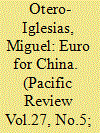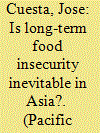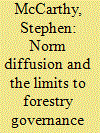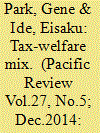|
|
|
Sort Order |
|
|
|
Items / Page
|
|
|
|
|
|
|
| Srl | Item |
| 1 |
ID:
135071


|
|
|
|
|
| Summary/Abstract |
Over the last 30 years, China has experienced tremendous growth, with many commentators attributing the rapid development to the ‘China Model’ (CM) or the ‘Beijing Consensus’ (BC). However, in recent years growth has slowed and an ever-increasing number of bears are predicting a financial crisis, economic collapse, and a very hard landing, perhaps even a lost decade a la Japan. All of this has led to heated debate about whether the CM is now exhausted, whether China is caught in ‘the middle-income trap’ (MIT) and whether a new model is needed for the next phase of development where China attempts the difficult transition from middle-income country to high-income country status. This article addresses the following five sets of issues. First, is there a CM or BC? If so, what does it entail, and does it differ from the model followed by other successful countries in East Asia? Second, is there a MIT? Is China stuck in the MIT or perhaps multiple MITs? Third, what adjustments to the economic model are required for China to continue its long march toward becoming a high-income country? Fourth, are political, legal and social reforms also required? If so, will all reforms proceed simultaneously or are reforms likely to be sequenced, with adjustments to the economy preceding reforms in other areas? Fifth, is there now a global convergence on a new model of development for developing countries – a Post-Washington, Post-Beijing Consensus?
|
|
|
|
|
|
|
|
|
|
|
|
|
|
|
|
| 2 |
ID:
135065


|
|
|
|
|
| Summary/Abstract |
Is the harmonization of financial regulatory regimes possible in East Asia? Focusing on corporate governance, which many see as a critical part of the 1997 Asian financial crisis, and which is also seen as unresponsive to calls for change, this paper argues that such harmonization is possible, but that it will not be according to the standards advocated by the International Monetary Fund, World Bank, Organisation for Economic Co-operation and Development, and other international organizations. At present, actors generally feign compliance with these international rules and standards. The pattern of noncompliance is reflective of two types of regulatory models at work in East Asia, which correspond to democratic and nondemocratic regimes. The manner by which these political institutions mediate the influence of key actors determines corporate governance outcomes. Three cases illustrate the key dynamics: Singapore (nondemocracy), South Korea (democracy), and pre- and post-World War II Japan (change from nondemocracy to democracy). By identifying the key actors that determine regulatory outcomes, this paper points to a more realistic regulatory framework. This alternative framework is a compromise between the standards advocated by international organizations and the domestic political realities of East Asia.
|
|
|
|
|
|
|
|
|
|
|
|
|
|
|
|
| 3 |
ID:
135075


|
|
|
|
|
| Summary/Abstract |
The aim of this paper is to analyze China's strategy in relation to the euro. The first section summarizes China's active support to the single currency since its creation up to the first phase of the current Eurozone debt crisis. It shows how China has used a two-pronged approach. It has developed a public campaign in favor of the euro, especially when the market sentiment has been bearish on the single currency, and it has continued to be an active player in the European sovereign debt markets. The second part explains why China has been so supportive. Beijing wants to move away from dollar hegemony and thus it favors a tripolar monetary system based on the US dollar, the euro and the Chinese renminbi (RMB). With this aim, and despite the crisis, China has continued to diversify its foreign reserves into the euro making it by now ‘too important to fail’, not only because China holds roughly $1 trillion in euro-denominated assets, but also because for China the Eurozone is a crucial market and an important strategic counterweight to US dominance in world affairs. Finally, the third part focuses on how by the end of 2011 China switches to a more cautious approach due to the difficulty involved in rescuing the Eurozone. Domestic pressures, public outcry in Europe against being saved by China, the unwillingness of the European leaders to enter into strategic bargaining and Germany's strategy to use sovereign bond spreads as a market mechanism to create ‘more Europe’ have convinced policy-makers in Beijing to keep a lower profile while making sure the value of the euro remains stable.
|
|
|
|
|
|
|
|
|
|
|
|
|
|
|
|
| 4 |
ID:
135084


|
|
|
|
|
| Summary/Abstract |
Many international relations (IR) scholars discuss whether the Association of Southeast Asian Nations (ASEAN) possesses institutional utility in maintaining security in Southeast Asia or East Asia. While this has important implications for both academics and policy-makers, ASEAN's role has been too often evaluated in terms of what has persisted within the association rather than what changed. Yet, exploring the causes and processes of institutional transformation are particularly important because they have made ASEAN expand its security utility by creating security dialogues and fostering security cooperation in the region. In this context, the crucial question is: when and how has ASEAN changed?
Focusing on the causes and processes of institutional transformation which have occurred within ASEAN, this article explores ASEAN's transformation from 1968 to 1976, by using a theoretical model, developed from historical institutionalism and the punctuated equilibrium model. Applying this approach to institutional transformation of ASEAN in the political-security field, three transformation processes are constructed. First, ASEAN member states’ expected changes in the external security environment triggered internal discussions regarding ASEAN's political-security function; second, these internal political discussions fostered institutional consolidation of ASEAN during this period; and third, such direction of institutional transformation was fundamentally guided by ideas provided by institutional norm entrepreneurs (INEs), especially Malaysia's neutrality proposal.
In particular, this article examines the process of ASEAN's creation of the Zone of Peace, Freedom, and Neutrality (ZOPFAN) in 1971, and the Treaty of Amity and Cooperation (TAC) and the Bali Concord in 1976, and argues that this model shed light on the significance of ZOPFAN that created a foundation of TAC and the Bali Concord, for which conventional wisdom has dismissed as an insignificant institutional concept by academics and practitioners.
|
|
|
|
|
|
|
|
|
|
|
|
|
|
|
|
| 5 |
ID:
135066


|
|
|
|
|
| Summary/Abstract |
This article questions two widely accepted claims on long-term food insecurity in Asia, the world's (heterogeneous) region with the largest number of undernourished individuals. The first claim is that food production may not grow as fast as the pace of population growth in Asia, which will reach 5 billion by 2050. The second claim is that an unstoppable emergence of a middle class in Asia will dramatically change the composition of food demand. On the first claim, the region's contribution to high and volatile international food prices is well known, but Asia's potentially positive contributions toward future price uncertainty and productivity growth are much less cited. On the second claim, the changing composition of future food demand in the region will depend on the extent that poverty reduction effectively leads to middle class expansion, which it is not an automatic process, and its extent still remains to be seen. Past evidence teaches us that poverty reduction on its own will not do the job of eradicating hunger, nor will only increasing food production. The jury is still out, but doomsday predictions are not necessarily justified.
|
|
|
|
|
|
|
|
|
|
|
|
|
|
|
|
| 6 |
ID:
135069


|
|
|
|
|
| Summary/Abstract |
With the Gulf War as a trigger, Japan began to make a humanitarian contribution by dispatching the Self Defense Forces to United Nations peacekeeping operations. Given Japan's strong hesitation for participation in the past, Japan's peacekeeping policy presents an intriguing challenge to examine the factors for a preference change and sustained compliance. By investigating Japan's peacekeeping policies towards East Timor and Haiti, this article examines how Japan's behavior and preferences were influenced by either internalized norms or cost/benefit calculations. While norm-driven behavior is considered to be incompatible with strategic calculated behavior, the article demonstrates that these two factors can co-exist.
|
|
|
|
|
|
|
|
|
|
|
|
|
|
|
|
| 7 |
ID:
135086


|
|
|
|
|
| Summary/Abstract |
The return of the World Bank Group (WBG) to Burma after some 25 years’ absence, along with other international financial organizations, follows a series of extraordinary political reforms that have taken place in the country since 2010. Burma has made a transition from 50 years of authoritarian rule to what its leaders call ‘disciplined democracy’. This paper examines the likely consequences of the Bank's return for the forestry sector in Burma and the potential outcomes in forestry governance given the evolution of its development agenda over the past 25 years. While measures to address deforestation have been applied in Southeast Asia, the success of forestry governance reforms depends to a large extent on their endorsement and adoption by local power structures and political figures, as well as on the nature of the political regime itself. The record on forestry governance in Southeast Asia is particularly poor and international financial organizations continue to neglect the local political economy of deforestation. Comparatively, few studies have attempted to investigate the relationship between types of political regimes and rates of deforestation. The paper examines two other new democracies in Southeast Asia (Indonesia and Cambodia), and the impact that governance reforms have had on their deforestation trends and land use, in order to contextualize the potential impact of the WBG's return to Burma. In Southeast Asia, powerful vested interests continue to outweigh the support inside governments or civil society for the forestry governance norms promoted by international organizations. The cases of Indonesia, Cambodia and Burma illustrate that deep patrimonial interests operate within the region and that local politics cannot be ignored by international organizations designing policy reforms. The WBG should effectively engage wherever possible with the local communities and a broad range of civil society groups before developing further initiatives.
|
|
|
|
|
|
|
|
|
|
|
|
|
|
|
|
| 8 |
ID:
135073


|
|
|
|
|
| Summary/Abstract |
Despite having the highest level of public debt in the Organisation for Economic Co-operation and Development (OECD), higher than Greece or Italy, Japan has one of the lowest aggregate tax burdens of the advanced industrial democracies. This paper asks why Japan, once described as a strong developmental state, has had such a weak extractive capacity, an inability to raise revenues to confront deficits and public debt? In contrast to the existing explanations that focus on political institutions, partisan preferences, or economic globalization, this article argues that Japan's ‘tax–welfare mix’ – the combination of taxes and redistributive welfare polices – undermined the state's long-term capacity to secure adequate tax revenue. More than just a source of revenue, taxes can be used directly to achieve redistributive goals, such as targeting low taxes and exemptions to specific groups. This study shows how Japan's tax–welfare mix diminished its extractive capacity through three mechanisms: the political lock-in of a redistributive social bargain struck around low taxes, the timing and sequencing of its tax policy and welfare development, and the erosion of public trust, which undermined tax consent. Beyond offering a new theory of extractive capacity, the tax–welfare mix explains aspects of Japan's tax structure that defy existing explanations and contributes to our understanding of the capitalist development state by highlighting the redistributive political function of tax policy and its long-term impact on state capacity.
|
|
|
|
|
|
|
|
|
|
|
|
|
|
|
|
|
|
|
|
|